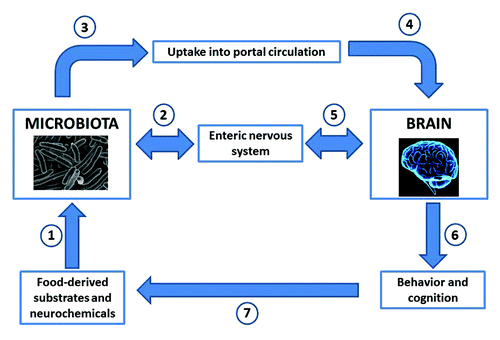Figures & data
Figure 1. The microbial endocrinology-based pathways by which neuroactive compounds produced by both the host and the microbiota can serve as a mechanism by which the brain and behavior can be modulated within the microbiota-gut-brain axis. Food ingested by the host contains both the substrates needed for neurochemical production by the host and the microbiota as well as fully functional neuroactive components (1). The microbiota in the gut is capable of either forming neurochemicals from the substrates present in the ingested food; or responding to the neuroactive food components themselves; or responding to neurochemicals secreted into the gut by components of the host enteric nervous system (2). Neurochemicals produced by the microbiota in the gut have two pathways by which to influence the host; they can either be taken up from the gut into the portal circulation (3) or they can directly interact with receptors found on components of the enteric nervous system which innervates the complete length of the gastrointestinal tract (2). Once in the portal circulation, microbiota-derived neurochemicals can influence components of the nervous system and ultimately the brain (4). Microbiota-derived neurochemicals can also influence components of the nervous system such as the brain through enteric nervous system-central nervous system communication (5). The result of either pathway (4) or (5) on the brain may result in an alteration of behavior or cognition (6) as well as food preferences and appetite (7).Citation23,Citation71 As described in the text, this should not be viewed as a one-way direction of only gut-to-brain since the brain may influence the composition of the microbiota through the specific release of neurochemicals into the gut lumen (2).

